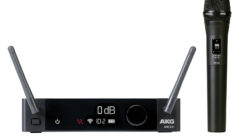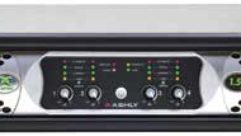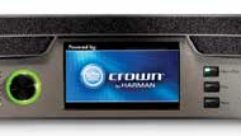
TOA 9000 Series
May 1, 2007 12:00 PM,
By John McJunkin
Combining the power of a mixer, matrix, and amplifier in a single box.

It’s a great idea: Combine a mixer/signal-routing matrix with an amplifier to facilitate simple, no-fuss blending and distribution of signals along with amplification. Toss in some nice DSP, and now you’ve got a really useful product that eliminates racks full of gear and enables simplified, yet sophisticated operation. TOA Electronics has introduced its 9000 series matrix/mixer-amplifier for this purpose, as an evolution of the industry-standard 900 series.
Among the device’s many applications, it can be used for office or retail telephone paging and music-on-hold, office or retail multi-zone paging, multi-zone paging with a night ringer, music-on-hold in a retail environment, and blending multiple AV sources with zone paging for a restaurant or bar. A digital message repeater can easily be integrated into the last of those aforementioned scenarios for a fitness club or other kinds of retail environments. Room combining is easily accomplished in a hotel or banquet environment with this series of products, as is teleconferencing or blending as many as eight microphones in a church or auditorium with either application including auto-mixing.
These are just a few of the applications simplified by these products. Due to their modular nature and user-programmability, they can be customized to handle just about any such application you can dream up, providing easily implemented solutions for contractors who need a lot of flexibility.
TOA offers six mixer/amplifier combos and a single mixer-only unit. The A-9060S provides a single channel of 60W power at 25V or 70V, or into 4Ω or 8Ω. The A-9120S provides a single channel of 120W power, also into 25V or 70V or into 4Ω or 8Ω loads. The A-9240SH offers a single channel at 240W for 70V systems, and the A-9060DH and A-9120DH provide 60W and 120W, respectively, for 70V systems. Finally, the A-9120DL provides two channels at 120W each into 4Ω to 16Ω loads.
The mixer with no amplification is known as the M-9000, which provides two line-level outputs. All flavors offer up to eight inputs in an 8×8 matrix. One feature I found particularly appealing is that 50 percent of either amplifier channel can be allocated to the other channel (obviously only in the two-amplifier units). Adding to the appeal of this function is that the power allocation is automatically determined by speaker load. I like this kind of automation.
One of the truly powerful features of this series is its modular nature. Each unit features eight ports to accommodate various modules. The D-001T is a dual mic/line input with DSP onboard. The A-9060DH that I test drove was shipped with a D-001T, which I was easily able to install and use. The T-001T is a dual-line output, also with DSP onboard. The ZP-001T is a DTMF-zone paging telephone module. The C-001T provides input/output control expansion, and the system is capable of impedance, VCA, and contact closure external controls, along with RS-232 computer interfacing.
Finally, the AN-001T enables ambient noise control, providing 24V of phantom power to a pair of microphones that report ambient noise levels back to the mixer/amp. The user can configure the mixer to increase (or decrease) gain automatically during times of the day when high ambient noise would otherwise drown out paging or BGM.
The first of the four accessories TOA offers for these systems is the AN-9001, a ceiling mic for the aforementioned AN-001T ambient-noise control module. The ZM-9001 is a remote switch panel that facilitates some pretty sophisticated control over the system. The ZM-9002 is a bit more sophisticated than the ZM-9001, with the inclusion of a volume knob. Finally, the SS-9001 is a four-zone speaker selector.
The front panel of all seven available units is simple and elegant. From left to right, you’ll first find eight momentary pushbutton switches that determine which input you’re adjusting. Next, in the center of the panel is a handsome alphanumeric LED display in blue, indicating input and output levels and matrix connections, among other things. Below the left side of the display you’ll find an input volume knob, along with an on/off switch, both dedicated exclusively to input channels. Below the right side of the display is an output volume knob, an on/off switch, and an output select button, which toggles through all the available outputs. To the right of the centered display section are data input buttons labeled “memory,” “enter,” “utility,” and “esc/back,” along with a data entry knob labeled “parameter,” and up, down, left, and right navigation buttons. Finally, on the far right is the unit’s power button. The front-panel controls can be selectively locked.
The far left side of the rear panel features an IEC power input, Phoenix-style speaker outputs corresponding to the number of amplifier channels, and a Phoenix block for control I/O. There is also a nine-pin RS-232 port, and finally, a slider switch that shifts between mixer and matrix modes (a change that requires power-down). To the right of this section are the eight module ports. Finally, on the far right are RCA power amp inputs and preamp outputs, again corresponding to the number of available amplifiers.
While the front panel facilitates access to all of the system’s functions (including over-the-phone maintenance and adjustments), the preferable way to program the unit is with the software available for download on the TOA website. TOA also offers MS Excel spreadsheet templates that may be more user-friendly to some programmers.
Maintenance software is included to facilitate the updating of firmware or monitoring of the system. The software provides a nice GUI-oriented way to route signals through the matrix and adjust DSP parameters, including 10-band parametric EQ, HPF, and LPF; bass and treble (low and high shelving); loudness contours, compression; ducking (with eight discrete levels); and delay. There are also optimal EQ presets available for TOA speakers.
There are two modes of operation — matrix and mixer. By far, the more complex is matrix mode, enabling some pretty sophisticated multi-zone paging applications. In programming matrix mode, the fundamental building block is the “event,” and once you’re accustomed to this nomenclature, it really becomes easy to customize the system to meet your requirements precisely. Mixer mode is simpler, facilitating the straightforward blending of signals, along with ducking and VOX paging. TOA provides plenty of resources to enable the user to fully comprehend and exploit the capabilities of the system.
I found the audio quality of the unit to be excellent with very little noise, and distortion is so low it’s laughable. In particular, I really like the ambient-noise compensation and auto-allocation of amplifier power in two-amp systems. The notion of mixer, matrix, and amplifier in a single box is a great idea to begin with, and it is brilliantly executed by TOA. If you want sophisticated multi-zone paging without racks full of gear, I strongly recommend a look at TOA’s 9000 series.
PRODUCT SUMMARY
Company: TOA Electronics
www.toaelectronics.com
Pros: Great quality, very usable for simple or complex applications.
Cons: None to speak of.
Applications: BGM, multi-zone paging, room combining, ambient-noise
compensation.
Prices: A-9060S: $1,146; A-9120S: $1,282; A-9240SH: $1,542; A-9060DH: $1,298; A-9120DH: $1,592; A-9120DL: $1,524; M-9000: $822; D-001T: $184
Specifications
Power bandwidth: 20Hz to 20kHz
Frequency response: 20Hz to 20kHz
Total harmonic distortion: 0.0008% to 0.008%
Signal-to-noise ratio: 90dB min. output volume, 61dB max. output volume, 110dB power amp section
Crosstalk: >64dB at 20kHz
Power source: 120VAC/60Hz
Operating temperature: 14 degrees to 104 degrees
Operating humidity: 35% to 80% relative humidity
Dimensions: 16.54”×4.24”1×5.55”
John McJunkinis the principal of Avalon Podcasting in Chandler, Ariz. He has consulted in the development of studios and installations and provides high-quality podcast production services.










